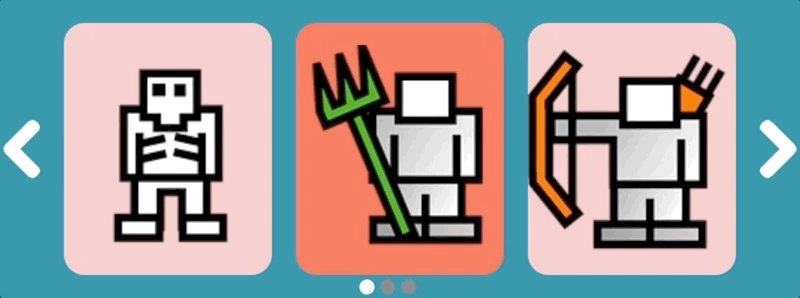Flexible images slider highly customizable for pygame.
Project description
pygame-imslider
Flexible images slider for Pygame engine.
Default

slider = ImSlider((800, 300))Multiple Slides

slider = ImSlider((800, 300), per_page=3, rewind=True)1 Slide Per Move

slider = ImSlider((800, 300), stype=STYPE_LOOP, per_page=3, per_move=1)Focus Center

slider = ImSlider((800, 300), stype=STYPE_LOOP, per_page=3, per_move=2, focus='center')Fade Transition

slider = ImSlider((800, 300), stype=STYPE_FADE, rewind=True, focus=False)Install
$ pip3 install pygame-imslider
Basic usage
ImSlider only require a pygame surface to be displayed on and a index consumer function, as in the following example :
from pygame_imslider import *
def consumer(index):
print('Current index : %s' % index)
# Initializes and activates ImSlider
slider = ImSlider((300, 100), callback=consumer)
slider.load_images(['image1.png', 'image2.png', 'image3.png',])The slider has the following optional parameters:
stype: determine a slider type: STYPE_SLIDE, STYPE_LOOP or STYPE_FADE
per_page: determine how many slides should be displayed per page. Ignored if stype=STYPE_FADE.
per_move: determine how many slides should be moved when a slider goes to next or perv. Ignored if stype=STYPE_FADE.
focus: determine which slide should be focused if there are multiple slides in a page. A string “center” is acceptable for centering slides.
rewind: whether to rewind a slider before the first slide or after the last one. Ignored if stype=STYPE_LOOP.
speed: transition duration in seconds.
renderer: a ImSliderRenderer to customize colors of the slider
callback: callback called each time the selection is changed.
Event management
A ImSlider object handles the following pygame event :
MOUSEBUTTONDOWN
MOUSEBUTTONUP
FINGERDOWN
FINGERUP
KEYDOWN
KEYUP
JOYHATMOTION
In order to process those events, slider instance event handling method should be called like in the following example:
while True:
events = pygame.event.get()
# Update internal variables
slider.update(events)
# Draw the slider
slider.draw(surface)
#
# Perform other tasks here
#
# Update the display
pygame.display.flip()The global performances can be improved avoiding to flip the entire display at each loop by using the pygame.display.update() function.
while True:
# Draw the slider
rects = slider.draw(surface)
# Update only the dirty rectangles of the display
pygame.display.update(rects)Custom rendering using ImSliderRenderer
If you want to customize slider rendering you could provide a ImSliderRenderer instance at ImSlider construction.
slider = ImSlider(size, renderer=ImSliderRenderer.DARK)Here is the list of default renderers provided with pygame-imslider:
ImSliderRenderer.DEFAULT
ImSliderRenderer.DARK
A custom ImSliderRenderer can be built using following constructor :
renderer = ImSliderRenderer(
# RGB tuple for arrow color (one tuple per state: released, pressed).
((255, 255, 255), (54, 54, 54)),
# RGB tuple for page-dot color (one tuple per state: released, pressed).
((120, 120, 120), (54, 54, 54)),
# RGB tuple for slide color.
(242, 195, 195),
# RGB tuple for selected image color.
(245, 95, 76),
# RGB tuple for selected page-dot color.
(255, 255, 255),
# RGB tuple for background color.
(32, 135, 156)
)You can also create your own renderer. Just override ImSliderRenderer class and override any of the following methods:
draw_arrow(surface, arrow): Draw an arrow.
draw_arrow_state(surface, arrow): Draw arrow state.
draw_dot(surface, dot): Draw a dot.
draw_dot_state(surface, dot): Draw page-dot state
draw_slide(surface, slide): Draw a slide.
draw_slide_state(surface, slide): Draw slide state.
draw_background(surface): Draw background.
Getting/Setting data
Several information can be retrieved from the slider:
slider = ImSlider(...)
# Load a sequence of image files.
slider.load_images(['image1.png', 'image2.png', 'image3.png'])
# Get a pygame.Rect object in which the slider is included.
slider.get_rect()
# Get the current pygame image (optionally resized).
slider.get_image(resized=False)
# Get the current index.
slider.get_index()
# Set the current index.
slider.set_index(2)
# Hide left and right arrows
slider.set_arrows_visible(False)Run examples
Several examples are provided with the pygame_imslider library. To run the examples, simply execute these commands in a terminal:
python -m pygame_imslider.examples.default
python -m pygame_imslider.examples.multiple
python -m pygame_imslider.examples.one_per_move
python -m pygame_imslider.examples.small_loop
python -m pygame_imslider.examples.focus
python -m pygame_imslider.examples.fadeContributing
If you develop you own renderer please share it ! I will keep a collection of rendering class in this repository. Don’t hesitate to report bug, feedback, suggestion into the repository issues section.
Project details
Download files
Download the file for your platform. If you're not sure which to choose, learn more about installing packages.
Source Distribution
Built Distribution
Hashes for pygame_imslider-1.0.2-py3-none-any.whl
| Algorithm | Hash digest | |
|---|---|---|
| SHA256 | 7cb68d72fe32fe064c04797fc35b3611315c67b11e7c031c69443b49e43d8dd3 |
|
| MD5 | 9dc7d48af8956b34299e0dbe0a986fa2 |
|
| BLAKE2b-256 | 9af515fdb3c66891ef44570147205d4b266ac2de01dba386c906f240db28d845 |














